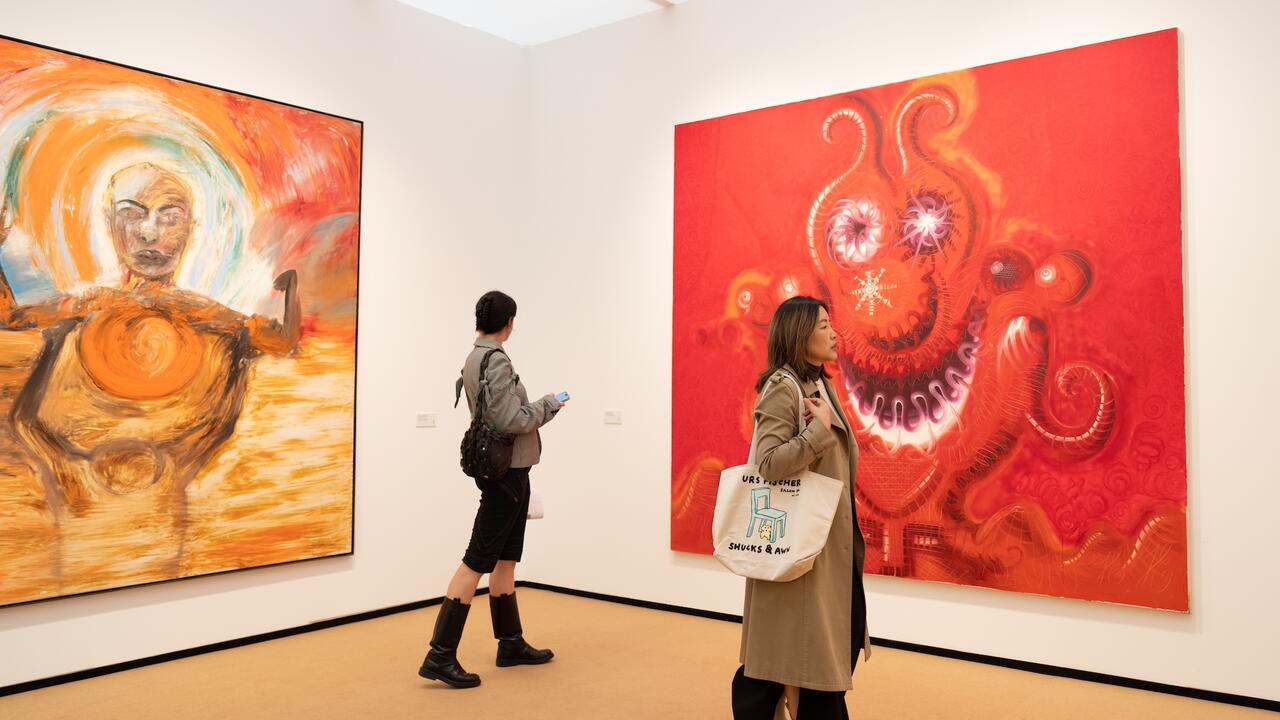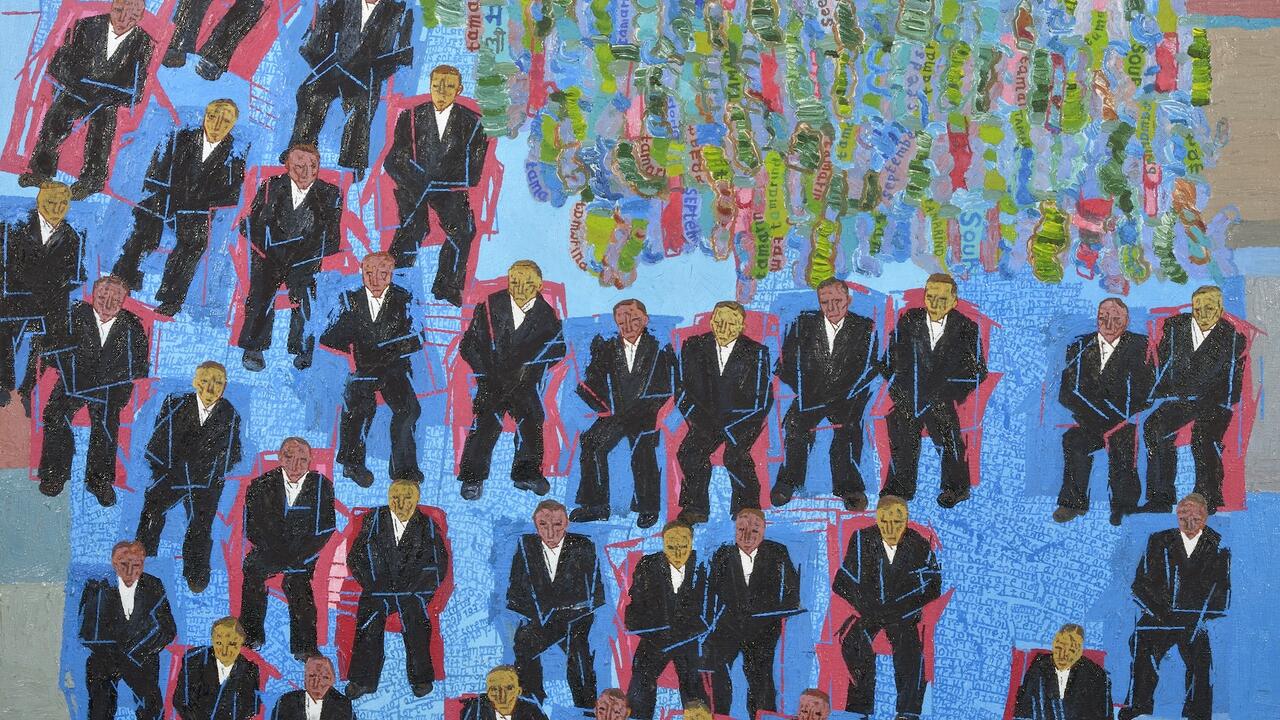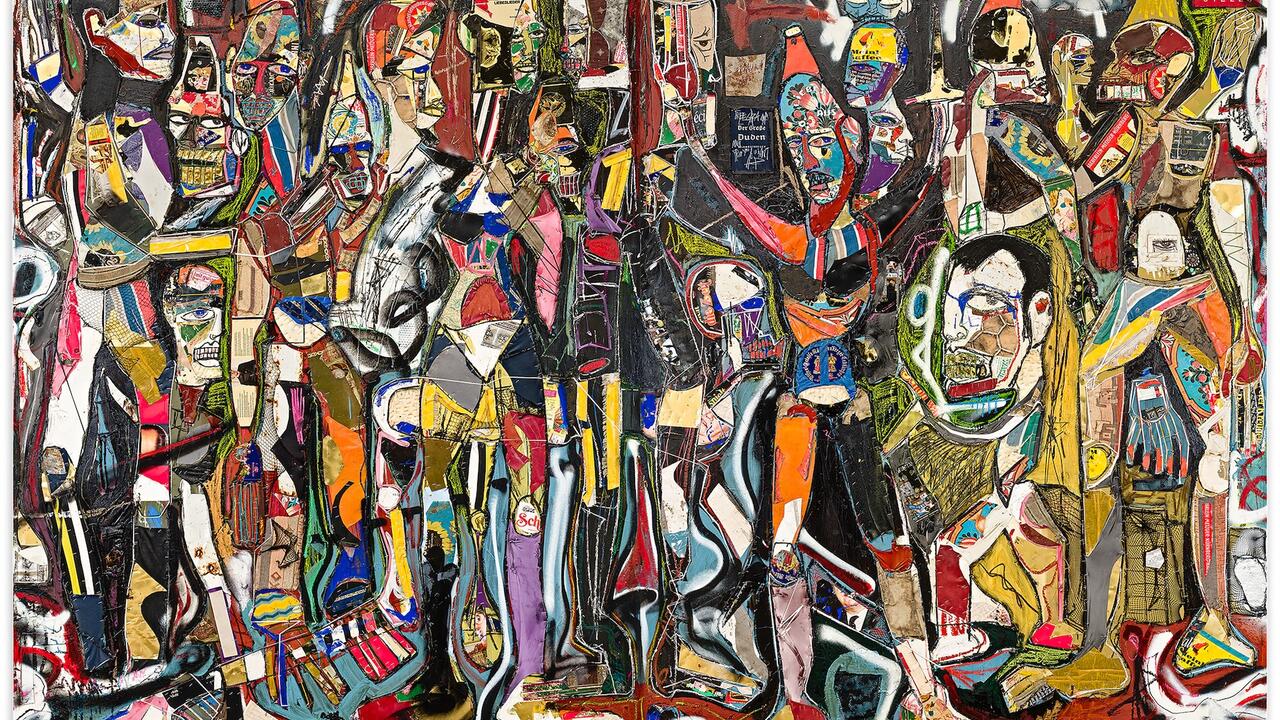Carnival Theory
Jennifer Higgie on the bewildered mystics, mournful minstrels and mysterious rituals of Ryan Mosley’s paintings
Jennifer Higgie on the bewildered mystics, mournful minstrels and mysterious rituals of Ryan Mosley’s paintings

I’m not convinced that you need me to explain Ryan Mosley’s paintings. Everything you need to know about them is right there, humming on the surface: trippy, funny and melancholy, these are virtuoso hallucinations in a high-keyed palette – hot pinks, fluorescent orange and wild flashes of cerulean blue. Mosley’s canvases are populated by merry turncoats, bewildered mystics and mournful minstrels, all coming or going or mutating into something or someone else: dancing, smoking, fleeing or wrestling, making music, performing enigmatic rituals or just sitting, staring into space. Many of them appear to be searching for something, be it salvation, a god or a good time. Bodies sprout limbs in unexpected places; tops hats commingle with topiary; an avalanche of umbrellas, pipes, skulls, cacti and caps, birds, banjos, beans and boots tumble from painting to painting. Like out-takes from fairy tales, the works have a narrative thread buried deep beneath their surfaces, but if you’re after a beginning, a middle and an end, then you’re bound for disappointment: nothing so straightforward exists here.
The head – the source of all thinking and dreaming – and what contains and covers it, is a recurring theme. Mosley – and I don’t think it’s an exaggeration to say so – is haunted by hats: towering top hats, floppy brown caps and huge hair that may as well be a hat. As in life, faces are complicated: like mad flowers sprouting from the same stem, there are often more than one on a single neck or lots of them embedded in someone’s hair (Oak Maiden, 2008); they also have a tendency to morph into masks. Beards are popular not, I assume, because they’re fashionable, but because in Mosley’s world there is no time to shave and, anyway, in these eccentric lands I suspect barbers are thin on the ground. Dead heads, like a chorus of tipsy memento mori, also occasionally make an appearance, but they’re not particularly gloomy. In Dance of the Nobleman (2010–11), for example, skulls float about a dancing man like dreamy girls at a party, while an audience of blank, uniform heads watches them.

Checked or diamond-patterned cloth weaves in and out of this work, a signifier of carnivals and the liberation that they – and their costumes and masks – allow. To my mind, imaginary carnivals, conduits for mental release, are as important as actual ones. In Nature Boy (2010), a single, pipe-smoking figure, graced with what appears to be a false beard, has paused, either mid-stride or mid-jig, to gaze into the distance: he is dressed in a skin-tight, harlequinesque body suit, surrounded by enormous fleshy leaves. This mix of heartiness, nature and burlesque is one Mosley returns to time and again. The limbs of the people who populate his pictures are almost uniformly strong, but they obviously need to be, required as they are to dance or stride or flee or cut their way through the foliage. They also leap about in time, at one moment evoking the fashions of hundreds of years ago and then casually drifting into our present from the future. Several of these oddballs seem full of purpose, but it’s the purpose of a stranger rushing past you in the street; where they’re going, or who they are, is anyone’s guess. They could be a bunch of mad aristocrats, momentarily freed from their lavish cells, or poor souls dancing with delusions of grandeur. They’re drunk and high and adventurous and furious and much more besides; they are, in fact, anything you want them to be. They’re wildly, hallucinogenically, colourful and then suddenly sombre; occasionally their skin is as mottled as old jewels.
Comedy – dark, light and in between – is never far off. Many of these paintings are like cartoons without a punchline and none the less for it. Take, for example, Smoking Pilgrimage (2014) – yes, a picture of a smoking pilgrim – in which the walking stick has sprouted a head that smokes a comradely pipe alongside his master. Mosley’s observations, like those of many great comedians, are both extroverted and oddly sensitive. No scenario is too strange, and yet it’s all strangely recognizable: the kind of tangle that happens in your head after a night of insomnia and champagne. (If it made sense to say that the paint and canvas seem, at times, to be having a lot of fun, I would.) Non sequiturs leap about like acrobats: in Piano Tuners (2011) there’s not a piano in sight; in Wandering Mind (2014) a head – presumably the container of said mind – is comprised of what appear to be elements of a chicken.

I met Mosley in a bar in London, while he was visiting from Sheffield, where he lives with his wife and children. I asked him about drawing and he explained that, for a long time, he had resisted doing preparatory sketches, as he preferred the images to develop according to their own logic, to allow ‘the paintbrush to become the pencil’. He’s a strong believer in the idea that mistakes are useful, that the unexpected often results in something worthwhile. (He has, however, recently returned to making drawings in preparation for the paintings, ‘which are in constant flux’.) When he was at art school (he studied at Huddersfield University and then London’s Royal College of Art) he got ‘bored of making paintings that looked like they weren’t really doing anything or saying anything’ and ‘became fascinated by Sigmar Polke’s re-appropriation of Goya’s images’ and then ‘tried to make a link between Polke and Fiona Rae and Jonathan Lasker’. At art school, he read a lot of theory but found many so-called ‘political’ painting ‘unacceptable because they often employ images taken directly from newspapers or film’; he felt that ‘painting them was sort of sanitizing these terrible things’. After graduation, he worked for a while as a room warder at London’s National Gallery. He told me that it was ‘easy to spend a whole afternoon there, to return month after month and obsessively look at the collections, especially ones that explore fables and folklore’. His job inspired him to read the Greek myths that had informed numerous works in the collection. His conversation is peppered with references to Goya, Philip Guston, Edouard Manet and Odilon Redon; he finds it curious that it’s still important to paint a figure when you can take a photograph or make a film, although why this is isn’t clear to him. He’s ‘obsessively drawn to painting figures – it doesn’t make sense but I do it’. He told me how charmed he was when he first saw Dana Schutz’s mingling of ‘humorous abstraction and figuration’ and that he aims to make works that ‘can embody their own contradictions and do something very interesting with both fact and imagination’. He travelled to Australia to see Sidney Nolan’s ‘Ned Kelly’ (1946–47) series of paintings, as he felt that they achieved this intermingling of fact and fiction. As for his titles, he told me that they weren’t biographical, but were ‘absurdities’ that gave the images a ‘tentative link to normality’ while attempting to ‘be more or less daft’.

Mosley has a show opening at Galerie Eigen + Art in Berlin in May, for which he’s preparing a range of work, from ‘tiny A5 drawings’ to three-metre-tall paintings. He tells me that the title of the exhibition, which alludes to chasing elusive ideas, is ‘The Mirror Never Reflects’. This is also the name of a central work that is a ‘painting of paintings which make up the genres of all my favourite painters’. One work in Mosley’s show late last year at Susanne Vielmetter Los Angeles Projects, The Plateau Fringe (2014), was, according to the artist, ‘sailing amongst uncharted ideas and motifs’ and has become the ‘DNA encryption’ of what’s to come. The theme, he tells me, refers to a house of mirrors, a place where reflections are ‘distorted manipulations of what is possible’. It’s a place I can imagine Mosley’s quite at home in.
Ryan Mosley lives in Sheffield, UK. His solo show at Galerie Eigen + Art, Berlin, Germany, opens in May. In 2014, Mosley had solo shows at Alison Jacques Gallery, London, and Susanne Vielmetter Los Angeles, USA. One of his paintings is currently included in 'One Day Something Happens: Paintings Of People' (A Hayward Touring & Arts Council Collection exhibition curated by Jennifer Higgie), which is on view at Leeds Art Gallery, UK, until 24 May. Mosley's work was also shown as part of 'The Islanders' at Galerie Mikael Andersen, Copenhagen, Denmark, earlier this year.






















